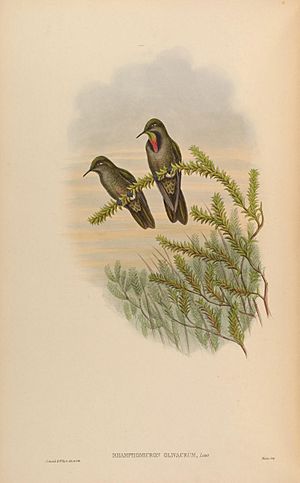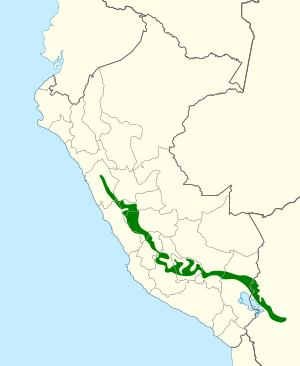Olivaceous thornbill facts for kids
Quick facts for kids Olivaceous thornbill |
|
|---|---|
 |
|
| Conservation status | |
| Scientific classification | |
| Genus: |
Chalcostigma
|
| Species: |
olivaceum
|
 |
|
The olivaceous thornbill (Chalcostigma olivaceum) is a type of hummingbird. It belongs to a group called "coquettes". You can find this small bird in the countries of Bolivia and Peru.
Contents
About the Olivaceous Thornbill
Hummingbirds are amazing birds known for their tiny size and fast-flapping wings. The olivaceous thornbill is one of these special birds. Scientists are still learning about how this bird fits into the larger family of hummingbirds. It has two main types, called subspecies: C. o. olivaceum and C. o. pallens.
What Does It Look Like?
The olivaceous thornbill is about 12 to 15 centimeters (5 to 6 inches) long. A male bird might weigh around 8.2 grams, and a female about 6.6 grams. That's lighter than a pencil! Both male and female birds have a short, black beak.
Adult males are mostly a dull, dark bronze or olive green color. This color covers their body and tail. Their face and throat are a dark, sooty gray. They have a special patch of feathers on their throat called a gorget. This gorget is very shiny. It starts as glittering green at the top and changes to yellow, pink, purple, and then blue at the bottom.
Adult females look similar to males. However, their gorget is much smaller, or sometimes it might not be there at all. Young birds have light tan edges on some of their feathers. Young males have gray-brown throats, while young females have gray-brown throats with pale edges.
The subspecies C. o. pallens is a bit smaller and lighter in color than the main subspecies. Its upper parts look more grayish, and its tail is a bronzy olive-brown. Its belly is a dark, sooty brown.
Where It Lives and Its Home
The main type of olivaceous thornbill (C. o. olivaceum) lives in southeastern Peru, from a place called Apurímac, all the way to the La Paz Department in Bolivia. They are found almost everywhere along this path.
The other subspecies, C. o. pallens, lives on the western side of the Peruvian Andes mountains. You can find it between the departments of Ancash and Junín. This subspecies is found in fewer, scattered places.
These birds live in high places. In Peru, they are found between 3,500 and 4,700 meters (11,500 to 15,400 feet) above sea level. In Bolivia, they live between 3,100 and 4,500 meters (10,200 to 14,800 feet) high.
They mostly live in somewhat wet puna grasslands. These are high-altitude grasslands. They also live in low bushes and at the edges of thick forests. These forests often have Polylepis and Gynoxys trees.
Behavior and Life
The olivaceous thornbill does not travel far. It stays in the same area all year round.
What It Eats
This hummingbird eats both nectar from flowers and small insects. While we don't know all the details of its diet, it seems to eat more insects than nectar. It often looks for food close to the ground. Sometimes, it even walks on matted grass!
It catches small insects by flying out from the ground to grab them. It also picks them off low plants. Male thornbills protect their feeding areas from other birds.
Reproduction and Life Cycle
Scientists are still learning about how the olivaceous thornbill reproduces. It seems they breed around January, but the full breeding season is not yet known. They might build their nests in Polylepis or Gynoxys woods. Like most hummingbirds, the female bird takes care of the eggs all by herself. She usually lays two eggs.
Its Call
As of early 2022, there was only one recording of an olivaceous thornbill's sound. It was described as a "tzit" call.
Conservation Status
The IUCN (International Union for Conservation of Nature) has listed the olivaceous thornbill as a species of Least Concern. This means it is not currently in danger of disappearing. It lives across a large area. However, the total number of these birds is not known, and it is thought that their population might be getting smaller. Some people describe it as rare, while others say it is uncommon in different parts of its home range. Human activities do not seem to have a big direct effect on the olivaceous thornbill in the short term.
See also
 In Spanish: Colibrí oliváceo para niños
In Spanish: Colibrí oliváceo para niños


